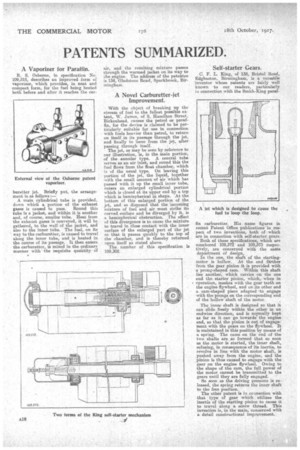PATENTS SUMMARIZED.
Page 24

If you've noticed an error in this article please click here to report it so we can fix it.
A Vaporizer for Paraffin.
R. S. Osborne, in specification No, 109,318, describes an improved form of vaporizer, which provides, in neat and compact form, for the fuel being heated both before and after it reaches the car, buretter jet. Briefly put, the arrangement is as follows:—
A main cylindrical tube is provided, down which a portion of the exhaust gases is caused to pass. Round this tube is a jacket, and within it is another and, of course, smaller tube. Heat from the exhaust gases is conveyed, it will be gathered, to the wall of the jacket, and also to the inner tube. The fuel, on its way to the carburetter, is caused to travel along the inner tube, and is heated in the course of its passage. It then enters the carburetter, is mixed in the ordinary manner with the requisite quantity of
air, and the resulting mixture passes through the warmed jacket on its way to the engine. The address of the patentee is 134, Gladstone Road, Sparkbrook, Birmingham.
A Novel Carburetter-jet Improvement.
With the object of breaking up the stream of fuel to the fullest possible extent, W. James, of 9, Hamilton Street, Birkenhead causes the petrol or paraffin, for the device is claimed to be particularly suitable fig use in connection with fuels heavier than petrol, to return on itself in its passage through the jet, and finally to issue from the jet, after passing through itself. The jet, as may be seen by reference to i our illustration, s, in the main portion, of the annular type. A central tube serves as an air inlet, and round this the fuel flows from the float chamber, which is of the usual type. On leaving this portion of the jet, the liquid, together with the small amount of air which has passed with it up the small inner tube, enters an enlarged cylindrical portion which is closed at its upper end hy a top which is hemispherical in shape. At the bottom of this enlarged portion of the jet, and so disposed that the 'incoming mixture of fuel and air must strike its curved surface and be diverged by it, is a hemispherical obstruction. The effect of this divergence is to cause the mixture to travel in close contact with the inner surface of the enlarged part of the' jet so that it passes quickly to the top of the chamber, and is thereby returned upon itself as stated above. The number of this specification is 109,308.
Self-starter Gears.
C. F. L. King, of 138, Bristol Rosd, Edgbaston, Birmingham, is a versatile inventor whose patents are fairly well known to our readers, particularly in connection with the Smith-King paraf fin carburetter. His name figures in recent Patent Office publications in respect of two inventions, both of which are in connection with self-starter gears. Both of these specifications, which are numbered 109,372 and 109,373 respectively, are concerned with the sarne department of design In the one, the shaft of the startingmotor is hollow. At the end farther from the gear pinion it is provided with a prong-shaped cam. Within this shaft lies another, which carries on the one end the starter pinion, which, when in operation, meshes with the gear teeth on the engine flywheel, and on its other end a cam-shaped piece adapted .to engage with the prongs on the corresponding end of the hollow shaft of the motor.
The inner shaft is designed so that it can slide freely within the other in an endwise direction, and is normally kept as far as it can go towards the engine end, so that the pinion is out of engagement with the gears on the flywheel. It is maintained in this position by means of a spring. The cams on the end of the two shafts are so formed that so soon as the motor is started, the inner shaft, refusing, in consequence of its inertia, to revolve in line with the motor shaft, is pushed away from the engine, and the pinion is thus caused to engage with the gear on the engine flywheel. Owing to the shape of the cam, the full power of the motor cannot be transmitted to the gears until they are fully engaged. So soon as the driving pressure is released, the spring returns the inner shaft to the free position. The other patent is in connection with that type of gear which utilizes the inertia of the starting pinion to cause it to travel along a screw thread. This invention is, in the main, concerned with a detail constructional improvement.
























